The principle of winterkill insurance is very straightforward: if the density of the plants between sprouting in autumn and the renewal of vegetation in spring decreases of 50% or more, the insured receives the full indemnity for that field (less the deductible). The decrease in density should be a result of the occurrence of one of the covered weather risks (frost being the most common).
Example:
The density of the plants for a specific field was 23 sprouts / sqm on Nov 24, 2016.

During the winter the sprouts suffer from severe frost and on April 10, 2016, the loss adjuster measures a density of 7 surviving sprouts / sqm. That corresponds to a 70% decrease in density which means that the field qualified for the payment of an indemnity by the insurance company.
